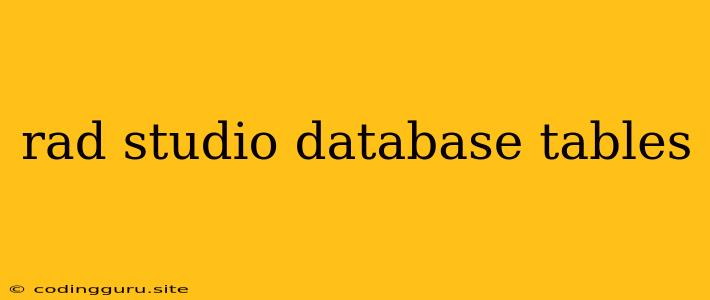Embracing the Power of Database Tables in RAD Studio
RAD Studio, a powerful integrated development environment (IDE) for building cross-platform applications, allows you to seamlessly integrate with databases. One of the fundamental concepts in this integration is database tables. Understanding how to work with database tables in RAD Studio is crucial for creating robust applications that can store, retrieve, and manipulate data effectively.
What are Database Tables?
At its core, a database table is a structured collection of data organized in rows and columns. Each row represents a single record, and each column represents a specific attribute or field.
Think of it like a spreadsheet:
- Rows: Each row represents a different item (e.g., a customer, a product, an order).
- Columns: Each column represents a specific piece of information about that item (e.g., customer name, product price, order date).
Why Use Database Tables with RAD Studio?
- Organized Data: Database tables provide a structured and organized way to manage your application's data.
- Data Integrity: Database management systems enforce data integrity rules, ensuring accuracy and consistency.
- Data Security: Databases offer robust security features to protect your sensitive data.
- Data Sharing: Multiple applications can access and share data stored in a database, promoting collaboration and efficiency.
Working with Database Tables in RAD Studio
RAD Studio offers a range of tools and components that simplify working with database tables. Let's explore some key aspects:
1. Connecting to Databases:
- Data Access Components: RAD Studio provides components like
TADOConnection,TDBXConnection, andTIBConnectionfor connecting to various database types like MySQL, PostgreSQL, SQL Server, and SQLite. - Connection Strings: You need to define a connection string to establish a connection to your database. This string specifies the database type, server name, database name, username, and password.
2. Data Access and Manipulation:
- Dataset Components: RAD Studio offers dataset components like
TADOQuery,TIBQuery, andTDBXQueryto fetch data from database tables. These components allow you to execute SQL queries and retrieve data into a structured format. - Data Controls: Use visual controls like
TDBGrid,TDBEdit,TDBComboBox, andTDBMemoto display, edit, and manipulate data from your database tables.
3. Data Management:
- SQL Queries: Utilize SQL queries to interact with database tables for tasks such as inserting, updating, deleting, and retrieving data.
- Stored Procedures: For more complex operations or for enhancing security, create stored procedures in your database. RAD Studio allows you to call stored procedures from your applications.
4. Code Examples:
Let's illustrate with a simple example:
// Connect to a database
ADOConnection1.ConnectionString := 'Provider=SQLOLEDB;Data Source=MyServer;Initial Catalog=MyDatabase;Integrated Security=SSPI;';
ADOConnection1.Connected := True;
// Create a query to select data from a table
ADOQuery1.Connection := ADOConnection1;
ADOQuery1.SQL.Add('SELECT * FROM Customers');
// Open the query and display results in a grid
ADOQuery1.Open;
DBGrid1.DataSource := ADOQuery1;
5. Best Practices:
- Normalize your database: Design your database tables following normalization principles to avoid data redundancy and ensure data integrity.
- Use parameterization: Employ parameterized queries to prevent SQL injection vulnerabilities.
- Validate user input: Before storing data in your database tables, validate user input to maintain data quality.
- Transaction handling: Utilize transactions to ensure data integrity and prevent inconsistencies during multiple database operations.
Working with Database Tables - Beyond the Basics
As your applications grow, you may need to explore more advanced database concepts:
- Relationships between tables: Create relationships between database tables using primary keys and foreign keys to enforce data consistency.
- Data integrity constraints: Define constraints such as unique keys, check constraints, and foreign key constraints to enforce data rules and maintain data integrity.
- Indexing: Create indexes on your database tables to optimize query performance.
Remember:
- RAD Studio provides a comprehensive set of tools and components for seamlessly interacting with database tables.
- By understanding the fundamentals of database tables and utilizing best practices, you can create robust, scalable, and efficient applications that manage data effectively.
Kesimpulan
Database tables form the foundation for storing and managing data in applications built with RAD Studio. By understanding the concepts of database tables and utilizing RAD Studio's powerful tools, developers can create applications that efficiently interact with databases to store, retrieve, and manipulate data effectively. This knowledge is essential for building robust, scalable, and data-driven applications.
